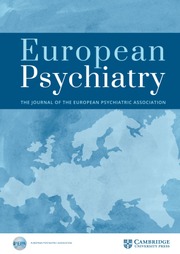Crossref Citations
This article has been cited by the following publications. This list is generated based on data provided by
Crossref.
Malhi, Gin S
Byrow, Yulisha
Fritz, Kristina
Das, Pritha
Baune, Bernhard T
Porter, Richard J
and
Outhred, Tim
2015.
Mood disorders: neurocognitive models.
Bipolar Disorders,
Vol. 17,
Issue. S2,
p.
3.
Vai, Benedetta
Poletti, Sara
Radaelli, Daniele
Dallaspezia, Sara
Bulgarelli, Chiara
Locatelli, Clara
Bollettini, Irene
Falini, Andrea
Colombo, Cristina
Smeraldi, Enrico
and
Benedetti, Francesco
2015.
Successful antidepressant chronotherapeutics enhance fronto-limbic neural responses and connectivity in bipolar depression.
Psychiatry Research: Neuroimaging,
Vol. 233,
Issue. 2,
p.
243.
Guan, Xi‐ting
Lin, Wen‐juan
and
Tang, Ming‐ming
2015.
Comparison of stress‐induced and LPS‐induced depressive‐like behaviors and the alterations of central proinflammatory cytokines mRNA in rats.
PsyCh Journal,
Vol. 4,
Issue. 3,
p.
113.
Caseras, Xavier
Murphy, Kevin
Lawrence, Natalia S
Fuentes‐Claramonte, Paola
Watts, Jessica
Jones, Derek K
and
Phillips, Mary L
2015.
Emotion regulation deficits in euthymic bipolar I versus bipolar II disorder: a functional and diffusion‐tensor imaging study.
Bipolar Disorders,
Vol. 17,
Issue. 5,
p.
461.
Benedetti, F.
Bollettini, I.
Poletti, S.
Locatelli, C.
Lorenzi, C.
Pirovano, A.
Smeraldi, E.
and
Colombo, C.
2015.
White matter microstructure in bipolar disorder is influenced by the serotonin transporter gene polymorphism 5‐HTTLPR.
Genes, Brain and Behavior,
Vol. 14,
Issue. 3,
p.
238.
Kinley, Jacqueline L.
and
Reyno, Sandra M.
2015.
Dynamic Relational Group Psychotherapy: A Neurobiologically Informed Model of Change.
International Journal of Group Psychotherapy,
p.
1.
Wang, Ying
Zhong, Shuming
Jia, Yanbin
Sun, Yao
Wang, Bing
Liu, Tao
Pan, Jiyang
and
Huang, Li
2016.
Disrupted Resting-State Functional Connectivity in Nonmedicated Bipolar Disorder.
Radiology,
Vol. 280,
Issue. 2,
p.
529.
Cardoso, Taiane de A.
Bauer, Isabelle E.
Jansen, Karen
Suchting, Robert
Zunta-Soares, Giovana
Quevedo, João
Glahn, David C.
and
Soares, Jair C.
2016.
Effect of alcohol and illicit substance use on verbal memory among individuals with bipolar disorder.
Psychiatry Research,
Vol. 243,
Issue. ,
p.
225.
Mukherjee, Prerona
Sabharwal, Amri
Kotov, Roman
Szekely, Akos
Parsey, Ramin
Barch, Deanna M.
and
Mohanty, Aprajita
2016.
Disconnection Between Amygdala and Medial Prefrontal Cortex in Psychotic Disorders.
Schizophrenia Bulletin,
Vol. 42,
Issue. 4,
p.
1056.
Benedetti, Francesco
Poletti, Sara
Hoogenboezem, Thomas A.
Mazza, Elena
Ambrée, Oliver
de Wit, Harm
Wijkhuijs, Annemarie J.M.
Locatelli, Clara
Bollettini, Irene
Colombo, Cristina
Arolt, Volker
and
Drexhage, Hemmo A.
2016.
Inflammatory cytokines influence measures of white matter integrity in Bipolar Disorder.
Journal of Affective Disorders,
Vol. 202,
Issue. ,
p.
1.
Cao, Bo
Bauer, Isabelle E.
Sharma, Ajaykumar N.
Mwangi, Benson
Frazier, Thomas
Lavagnino, Luca
Zunta-Soares, Giovana B.
Walss-Bass, Consuelo
Glahn, David C.
Kapczinski, Flavio
Nielsen, David A.
and
Soares, Jair C.
2016.
Reduced hippocampus volume and memory performance in bipolar disorder patients carrying the BDNF val66met met allele.
Journal of Affective Disorders,
Vol. 198,
Issue. ,
p.
198.
Chase, Henry W.
and
Phillips, Mary L.
2016.
Elucidating Neural Network Functional Connectivity Abnormalities in Bipolar Disorder: Toward a Harmonized Methodological Approach.
Biological Psychiatry: Cognitive Neuroscience and Neuroimaging,
Vol. 1,
Issue. 3,
p.
288.
Dima, D
Roberts, R E
and
Frangou, S
2016.
Connectomic markers of disease expression, genetic risk and resilience in bipolar disorder.
Translational Psychiatry,
Vol. 6,
Issue. 1,
p.
e706.
Chintoh, Araba F.
and
Young, L. Trevor
2016.
Bipolar Depression: Molecular Neurobiology, Clinical Diagnosis, and Pharmacotherapy.
p.
93.
Bollettini, Irene
Melloni, Elisa Maria Teresa
Aggio, Veronica
Poletti, Sara
Lorenzi, Cristina
Pirovano, Adele
Vai, Benedetta
Dallaspezia, Sara
Colombo, Cristina
and
Benedetti, Francesco
2017.
Clock genes associate with white matter integrity in depressed bipolar patients.
Chronobiology International,
Vol. 34,
Issue. 2,
p.
212.
Kinley, Jacqueline L.
and
Reyno, Sandra M.
2017.
Advancing Freud’s dream: A dynamic-relational neurobiologically informed approach to psychotherapy.
Neuropsychoanalysis,
Vol. 19,
Issue. 2,
p.
127.
Tu, Pei-Chi
Kuan, Yi-Hsuan
Li, Cheng-Ta
and
Su, Tung-Ping
2017.
Structural correlates of creative thinking in patients with bipolar disorder and healthy controls—a voxel-based morphometry study.
Journal of Affective Disorders,
Vol. 215,
Issue. ,
p.
218.
Zhang, Kerang
Liu, Zhifen
Cao, Xiaohua
Yang, Chunxia
Xu, Yong
Xu, Ting
Xu, Cheng
Yang, Zhi
and
Ebmeier, Klaus
2017.
Amplitude of low-frequency fluctuations in first-episode, drug-naïve depressive patients: A 5-year retrospective study.
PLOS ONE,
Vol. 12,
Issue. 4,
p.
e0174564.
Vai, B.
Riberto, M.
Poletti, S.
Bollettini, I.
Lorenzi, C.
Colombo, C.
and
Benedetti, F.
2017.
Catechol-O-methyltransferase Val(108/158)Met polymorphism affects fronto-limbic connectivity during emotional processing in bipolar disorder.
European Psychiatry,
Vol. 41,
Issue. 1,
p.
53.
Cazala, Fadwa
Suchting, Robert
Zeni, Cristian P.
Bauer, Isabelle E.
Mwangi, Benson
Wu, Mon-Ju
Passos, Ives Cavalcante
Spiker, Danielle E.
Zunta-Soares, Giovanna B.
and
Soares, Jair C.
2018.
Effects of valproate on brain volumes in pediatric bipolar disorder: A preliminary study.
Psychiatry Research: Neuroimaging,
Vol. 278,
Issue. ,
p.
65.



Comments
No Comments have been published for this article.